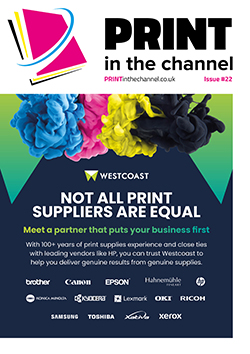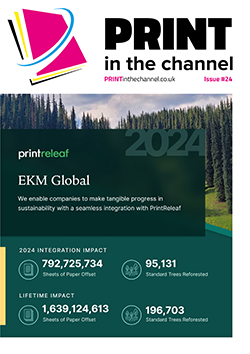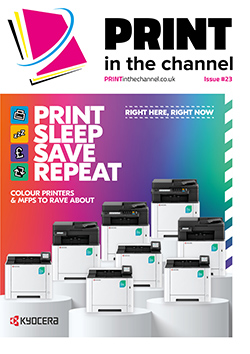For many businesses, sustainability is a priority, but with economic growth slight, cost-cutting is also high on the agenda. When looking at printers, customers want energy efficiency to cover both priorities.
With the economy continuing to register slow-to-zero growth, these are tough times for businesses, and many are looking to find savings wherever possible. At the same time, pressure to be more sustainable continues to build. So, if a business can find a way of saving costs and becoming more sustainable, so much the better. And energy efficient printers can help to achieve this.
James Knox, head of corporate responsibility/ESG at Ricoh UK, notes: “ESG is no longer a corporate luxury, incumbent and prospective customers are now basing buying decisions on added value – particularly around ESG benefits,” he says.
“As energy prices continue to fluctuate, businesses are prioritising carbon reduction, with energy efficiency in printers becoming a key contributor in the broader sustainability agenda. Not just for environmental impact, but also to combat rising operational costs. Energy efficient printers contribute to net-zero goals by helping to lower electricity bills and reduce carbon emissions.”
Dan Wogan, product manager for office printing at Epson UK, agrees that energy efficiency has become a key consideration in printer selection. “This is driven by financial necessity, environmental responsibility, but also fluctuating costs of electricity,” he says. “As businesses work to lower their carbon footprints and meet sustainability targets, reducing energy consumption is more critical than ever, but so too is their cost per Kwh and cutting total cost of ownership (TCO).”
Peter Dresser, product marketing manager at Kyocera Document Solutions UK, adds that minimising the energy usage of printers and multifunction printers (MFPs) offers cost savings and helps organisations lower their Scope 1 emissions to deliver tangible benefits in sustainability.
“Energy efficient devices are about more than just peak power consumption,” he says. “Buyers need to look at standby and sleep mode power usage, where devices spend most of their time. Eco-friendly printing modes reduce power usage even further on some printing products.”
Tony Ko, vice president of hardware and business solutions, Katun Corporation, adds that today’s MFPs must go beyond just energy efficiency. “They should offer a more holistic approach that prioritises reliability and streamlined operations, enabling businesses to succeed while minimising environmental impact and cutting long-term expenses,” he says.
Increasingly energy efficiency
Original equipment manufacturers (OEMs) have been working to make more energy efficient printers and are doing this in various ways.
James says Ricoh leverages the latest components and touch panel displays. “For example, our Smart Operation Panel uses 45% less power than the predecessor,” he says. “Furthermore, we have also implemented carbon offsetting programmes to help our customers achieve continuous environmental improvement, offering certification for ISO 14001.”
Tony notes that Katun’s Arivia MFPs include an auto-on capability that detects approaching users. “This minimising start-up time and ensuring immediate readiness without requiring power-on or standby mode,” he adds. “Arivia MFPs also include smart power routing that optimises energy use by activating only necessary components and customisable settings to track paper usage and reduce waste.
“Arivia MFPs also include LED print head technology that offers low-temperature fusing, conserving energy while providing excellent print performance. In addition, Induction Heating fusing technology provides quick heating allowing short start-up time without preheating fuser in stand-by or power saving mode.
“There is also reduced energy consumption with smart power routing, which optimises power usage by activating only necessary components. There is also ultra-low temperature EA toner featuring reduced power consumption during fusing. It also eliminates unnecessary print and paper waste with features including private charge print, scan and paperless fax.”
Stuart Miller, director UK&I Canon Channel Partners, says that in terms of power consumption, printers should be designed to perform at an extremely low wattage per print. “The new imageFORCE C7165 and several imageRUNNER ADVANCE DX models consume less than one watt of energy while in sleep mode,” he notes.
Bringing down the heat
Another way printers are becoming more energy efficient is using heat-free inkjet technology. “Printing has traditionally been an energy-intensive process, especially in workplaces where printers are continuously running and laser printers are common, which require significant heat to fuse toner onto paper,” says Dan.
“However, heat-free inkjet technology offers a far more energy-efficient alternative by eliminating the need for heat in the printing process. Research shows that if businesses worldwide transitioned from laser to inkjet, it could save 1.3 million metric tonnes of CO₂ annually.
“Heat-free inkjet printers do not need warm-up cycles. This reduces energy consumption and results in faster first-page-out times, improving overall productivity.”
Peter adds that another approach OEMs are taking is to streamline internal components, removing fans, motors and their associated circuitry to reduce heat, noise and power usage. “Reducing the heat a device generates has the added benefit of reducing office heat and hence the unseen impact on increased air conditioning costs,” he notes. “Technology such as Kyocera’s low melt toner is also playing its part, fusing 30 degrees Celsius below other toners it has the effect of cutting the energy used when printing by 50%. Kyocera’s latest range of ECOSYS colour printers boast an ultra-low sleep mode usage of just 0.3W for maximum energy savings.”
Gary Organ, head of device technology in the UK at Fujifilm, adds: “Fujifilm Apeos printers offer more energy efficiency through lower temperature fusing toner, energy saving modes, utilising recycled plastic and flame-resistant bio based plastics, induction heating to speed up heating the toner, smart power saving and more.
“OEMs like Fujifilm have sustainable product development for the good of the planet at its core, this minimises the environmental impact, ensures sustainable sourcing and certified recycling as well as minimise energy usage.”
More than just Kwh
Indeed, printers are becoming more energy efficient in a variety of ways – it isn’t just about Kwh. For instance, OEMs are increasing the percentage of post-consumer recycled plastic in device build. “Printers are manufactured with eco-friendly materials, longer-lasting components, and include features like duplex printing to cut paper use,” says James. “The Ricoh IM Cxx10 series uses 50% of post-consumer recycled plastic.
“Other sustainable features include recyclable cartridges, lower-emission consumables and packaging reduction. At Ricoh, our Green Line models are designed with the circular economy in mind.”
Stuart agrees OEMs are taking a holistic approach to energy efficiency. “At Canon, we are focused on maximising the lifespan of parts and reducing the use of raw materials,” he says. “From 2008 to 2023, we achieved a 44% reduction in the lifecycle emissions of our products.
“At the end of the product lifecycle, ink cartridge recycling and refurbishment programmes enable customers to contribute to the circular economy. At Canon, energy saving initiatives such as these are expected to achieve a CO2 reduction of 3.2 million tons, having a significant flow-on effect for our channel partners and their customers.”
Gary says that Fujifulm is putting continuous research and development into making its printers more energy efficient, including looking at resources, utilising recycled plastics, and delivering recycling solutions for consumable items. “Fujifilm launched its new circular manufacturing facility in Tilburg last May allowing initially Fujifilm to collect and recycle toners, drums, and other consumables and replenish with genuine toners made from the used plastics,” he notes. “This facility will expand to devices in the future.”
A part of this is offering extended warranties on printers. “With a warranty that can guarantee the printer’s serviceable lifetime for up to eight years, businesses are better ensuring the circularity of their device,” says Dan.
Ink is another factor. “Epson’s Replaceable Ink Pack System is featured in the latest Workforce Pro EM-C800RDWF and EP-C800RDW printers,” says Dan. “These models deliver high-yield ink packs capable of printing up to 50,000 pages in mono and 20,000 pages in colour before needing replacement. This significantly reduces the frequency of consumable changes and cuts down on the manufacturing, transportation, and disposal of ink packs, minimising environmental impact throughout the product’s entire lifecycle.”
Peter notes that for maximum environmental savings organisations should choose a supplier with a CSR approach that goes beyond the printer itself. “For instance, Kyocera Document Solutions UK is a carbon neutral company, offering carbon neutral devices and recycling programmes to minimise environmental impact,” he says.
Stuart notes that digitising processes through intelligent print solutions can play a crucial role. “As systems become more automated, we will see businesses embrace emerging technology such as AI to improve monitoring and assessment tools,” he says. “With the ability to learn patterns across devices and identify hidden inefficiencies, these tools will be able to predict and prevent maintenance requests automatically.
“It is also important to consider consumables as part of this bigger picture. Canon’s Zero paper range is leading the market in the development of climate-compensated paper. One year on since the launch of Canon’s Zero paper, we have compensated 783 tonnes of CO2 emissions.”
Difference
Using energy efficient printers does make a difference to a business’ sustainability targets. “Reduced waste such as paper toner and parts supports circular economy practices,” says James. “Particularly for businesses that have a large fleet, optimising energy efficiency with EcoMode and utilising data within our service solution Ricoh @Remote, can considerably reduce waste to achieve ESG targets.”
Dan says one of the most immediate benefits is a significant reduction in carbon emissions, particularly where printers are in continuous use. “Helping customers measure this impact using Epson’s Optimisation Calculator means that businesses can physically quantify the energy reduction and directly attributable carbon from the generation of that electricity,” he adds.
“Epson also offers an extended warranty that can guarantee serviceable life for up to eight years.”
Tony adds that product reliability plays a critical role in reducing impact and achieving sustainability targets. “High-quality, reliable MFPs require fewer resources for repairs or replacements. By integrating energy efficiency with product reliability, businesses can create more sustainable and cost-effective operations.”
Reseller notes
When talking to customers about the benefits of energy efficient printers, there are numerous things they should highlight. Cost savings is one. “Additionally, smart features such as automatic shutdown, low-energy standby and remote monitoring also contribute to cost savings,” says James. “Resellers can position energy efficiency as a factor that reduces operational costs over the printer’s life, reflecting on TCO.
“Resellers should emphasise how printers support regulatory compliance and green certifications, meeting eco-compliance standards.”
Dan agrees that resellers should highlight the long-term cost savings. “Many businesses still focus on upfront costs when purchasing hardware, but energy-efficient models deliver significant reductions in operational expenses over time. Lower electricity bills, fewer maintenance requirements, and reduced consumable waste all contribute to improved cost efficiency.”
Peter adds that the reduction in carbon emissions should be highlighted. “Device features such as ultra-low power sleep modes, reduced fusing temperatures, and proven reliability can significantly lower energy and unforeseen running costs,” he says.
Tony adds that resellers should also focus on customisable sustainability features. “Such as those that help reduce paper usage and minimise waste,” he says. “By showcasing these features, resellers can help customers achieve a smarter, greener office while also making smart financial and environmental decisions.”
Stuart says resellers need to educate customers. “As customers look to take their digital transformation to the next stage, resellers can optimise energy efficiency as part of this process,” he says. “By highlighting the effectiveness of MPS as a way to streamline processes and better monitor devices, resellers can help maximise the lifespan of customer equipment and the overall efficiency of their workflow.”









